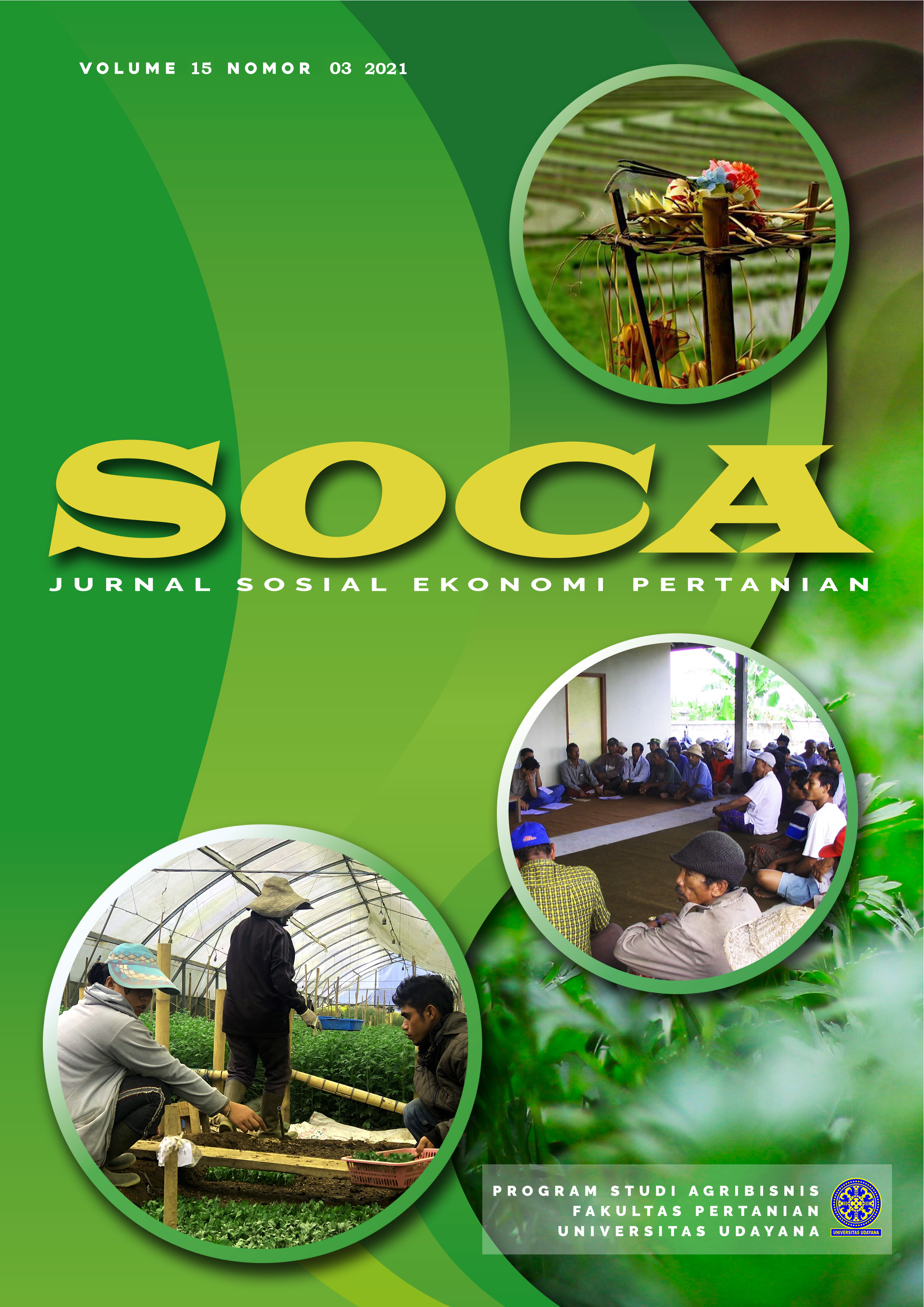Added-Value and Development Strategy of Arabica Coffee Manufacturing Business
Abstract
The manufacturing business of Arabica Coffee highly potential in increasing the selling value of the coffee commodity. Unfortunately, this business still faces some hindrances during its implementation. This study aimed to: (1) analyze the amount of added-value in the manufacturing process of Arabica Coffee and (2) analyze the development strategy required. The study conducted from December 2019 to February 2020 in six Arabica Coffee Manufacturing businesses in Tlahab Village. This case-study was involving 12 respondents and employing Hayami Method, IFAS matrix, EFAS matrix, and SWOT matrix as the data analysis method. Result showed that the mean of the added-value of the green bean and coffee powder, green-bean coffee and the coffee powder was IDR 3,425.44 and IDR 16,916.05, 26.45% (moderate added value) and 54.94% (high added value), respectively. The analysis from the IFAS and EFAS matrix resulted six factors of strength, five factors of weakness, five factors of opportunity, and three factors of threat. According to the SWOT diagram, the Arabica Coffee manufacturing business in Tlahab Village was in Quadrant I that indicated the strategy required was using the strength and utilizing the opportunities existed. Those strategies consisted of the utilization of all resources in Tlahab Village, improving cooperation between the stakeholder and business owner, and developing the marketing management used.
Downloads
References
Chethana, A. N., Nagaraj, N., Chengappa, P. G., & Gracy, C. P. (2010). Geographical Indications for Kodagu Coffee – A Socio-economic. Journal of Agriculture Economics, 23(June), 97–103.
David, F. R. (2011). Strategic Management Concepts and Cases. New Jersey: Pearson Education.
Dewi, N. L. M. I. M., Budiasa, I. W., & Dewi, I. A. L. (2015). Analisis Finansial dan Nilai Tambah Pengolahan Kopi Arabika di Koperasi Tani Manik Sedana Kabupaten Bangli. Jurnal Agribisnis Dan Agrowisata, 4(2), 97–106.
Hariyati, Y., & Rahayu, L. P. (2014). Agroindustri Kopi Arabika : Analisis Nilai Tambah, Saluran Pemasaran dan Sistem Manajemen Rantai Pasok. Jurnal Sosial Ekonomi Pertanian Dan Agribisnis, 10(2), 157–168. https://doi.org/10.1017/CBO9781107415324.004
Hayami, Y., Kawagoe, T., Marooka, Y., & Siregar, M. (1987). Agricultural Marketing and Processing in Upland Java a Perspective From a Sunda Village. Bogor: CGPRT Centre.
Hubeis, M. (1997). Menuju Indusri Kecil Profesional di Era Globalisasi Melalui Pemberdayaan Manajemen Industri (pp. 1–106). pp. 1–106.
Luitel, G. (2017). Value Chain Analysis of Coffee Production in Central Nepal. Institute of Agriculture an Animal Science.
Muthoni, M. P. (2014). Coffee Value Chain Analysis in Kenya (A case of Kenya Planters Cooperative Union). Journal of Business and Management, 6(5), 207–215.
Priantara, I. D. G. Y., Mulyani, S., & Satriawan, I. K. (2016). Analisis Nilai Tambah Pengolahan Kopi Arabika Kintamani, Bangli. Jurnal Rekayasa Dan Manajemen Agroindustri, 4(4), 33–42.
Rahardjo, P. (2017). Berkebun Kopi. Jakarta: Penebar Swadaya.
Statistik, B. P. (2018). Kabupaten Temanggung dalam Angka. Temanggung: Badan Pusat Statistik Temanggung.
Statistik, B. P. (2019a). Provinsi Jawa Tengah dalam Angka 2019. Badan Pusat Statistik Provinsi Jawa Tengah.
Statistik, B. P. (2019b). Provinsi Jawa Timur dalam Angka 2019. Badan Pusat Statistik Provinsi Jawa Timur.
Subedi, R. N. (2011). Comparative Analysis of Dry and Wet Processing of Coffee with Respect to Quality in Kavre District , Nepal. International Research Journal of Applied and Basic Sciences., 2(September), 181–193. Retrieved from https://scholar.google.com/scholar?hl=en&as_sdt=0%2C5&q=comparative+analysis+of+wet+and+dry+coffee+processing+qualitya+and+cost%2C+subedi+2011+nepal&btnG=
Sukiada, N. W. R. P., & Parameswari, A. A. A. I. (2020). Nation Branding Kopi Arabika Kintamani (Studi Kasus: Kopi Gunung Catur, Desa Catur, Kintamani, Bangli). SOCA: Jurnal Sosial, Ekonomi Pertanian, 14(1), 180–193. https://doi.org/10.24843/soca.2020.v14.i01.p15
Tambarta, E. (2017). Analisis Nilai Tambah dan Strategi Pengembangan Olahan Kopi Arabika di Kabupaten Bener Meriah Aceh. Institut Pertanian Bogor.
Yeretzian, C., Jordan, A., Badoud, R., & Lindinger, W. (2002). From the Green Bean to the Cup of Coffee: Investigating Coffee Roasting by On-line Monitoring of Volatiles. Journal of European Food Research and Technology, 214(2), 92–104. https://doi.org/10.1007/s00217-001-0424-7













